Below you will find gifs of the most popular and effective shoulder exercises.
Barbell Exercises
Military Press
- This primarily hits your anterior and lateral deltoids.
- In a true military press, the feet are together.
- This is one form of a strict press – you don’t generate any momentum with the legs as that’s considered cheating.
- Align your knuckles with the bar so that when you press, your forearms are under the bar (forearms in front of the bar = wrist stress)
- Choose a grip that allows the forearms to remain close to vertical for the movement
- A good cue for the top position is to push “behind the ears”, meaning the head comes through
- Avoid leaning back too much, doing so means the weight is likely too heavy
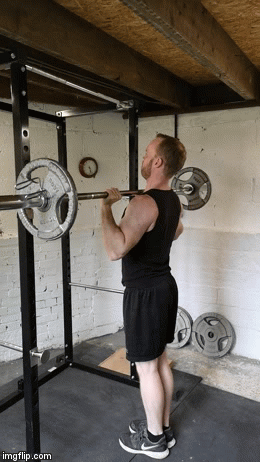
Seated Barbell Shoulder Press
- This primarily hits the anterior and lateral deltoids.
- Set the bench as close to vertical as possible
- Take a stance so that your legs feel in a strong position to help with balance
- Align your knuckles with the bar so that when you press, your forearms are under the bar (forearms in front of the bar = wrist stress)
- Choose a grip that allows the forearms to remain close to vertical for the movement
- A good cue for the top position is to push “behind the ears”, meaning the head comes through
- Avoid arching the back too much, doing so means the weight is likely too heavy. Think of keeping the rib cage down over the body
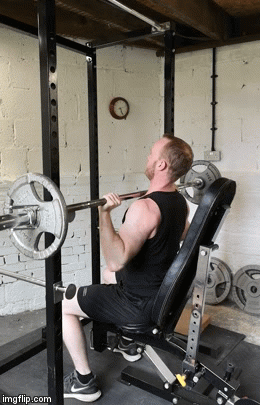
Standing Barbell Shoulder Press
- This primarily hits your anterior and lateral deltoids.
- Align your knuckles with the bar so that when you press, your forearms are under the bar (forearms in front of the bar = wrist stress)
- Choose a grip that allows the forearms to remain close to vertical for the movement
- Have soft knees and don’t use them to generate momentum (that would be a push press)
- A good cue for the top position is to push “behind the ears”, meaning the head comes through
- Avoid leaning back too much, doing so means the weight is likely too heavy
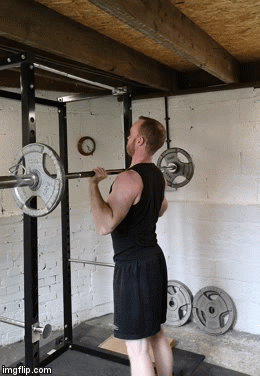
T-Bar Row
- These work your posterior deltoids as well as lats and middle traps
- Place an unloaded barbell so one end is in the corner of the room
- Load the other end, preferably with smaller diameter plates (allows for greater range of motion)
- Take a shoulder width or slightly wider stance and using interlocked fingers, grasp the barbell just inside the weight plates
- Engage the shoulders by pulling them back as well as bending the elbows, stopping when the plates touch your torso. Note that the use of a V Handle is recommended to allow for further range of motion.
- Lower to full extension of the arms, allowing the shoulder to come forward as well.
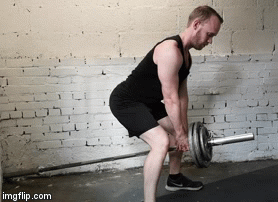
Dumbbell Exercises
Bent Over Dumbbell Reverse Flyes
- Also called the Rear Delt Raise, this hits your posterior deltoids.
- Assume a shoulder width or slightly wider stance, hinging at the hip with a flat back.
- Palms should be facing each other with a slight bend in the elbows.
- Pull the shoulder blades back throughout the movement.
- Raise the dumbbells up and out rather than trying to bring them together behind the body
- Pause briefly and lower under control. You do not need to go heavy on this exercise.
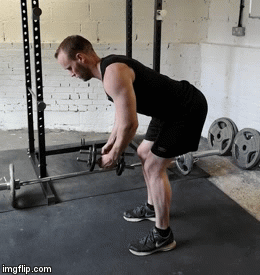
Dumbbell Front Raise
- This primarily targets the anterior deltoids. If you do plenty of horizontal and incline pressing e.g. bench press, it’s likely you don’t need to isolate these muscles in any additional exercise.
- For increased activation, do this seated on a high incline, putting the front deltoid in a more stretched position at the bottom of the movement.
- Have the backs of your hands facing away, with a slight bend in the elbows.
- Raise the dumbbells in a controlled manner, stopping when level with the shoulders. Any higher can cause shoulder impingement.
- Pause briefly and lower slowly, returning the arms back behind the body.
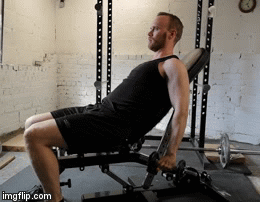
Dumbbell Shoulder Press
- This primarily hits your anterior and lateral deltoids.
- It can be done either seated or standing.
- Elbows should not be excessively pulled backwards
- Engage the core so you have a stable position to push off.
- Have the wrists facing forward with the forearms near vertical and positioned under the handles.
- Dumbbells should travel vertically and naturally come in as the elbow straightens.
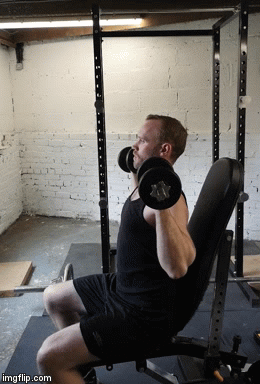
Dumbbell Side Lateral Raise
- Unsurprisingly, this hits the lateral deltoids.
- Take a slight bend in the elbow and have palms facing each other.
- Pull the shoulder blades back and have a neutral head.
- Raise the dumbbells so the wrists are level or slightly below shoulder height. Note that’s it common to get shoulder impingement from lifting any higher than that (my demo is perhaps a touch high).
- Pause for a split second and lower slowly, most of the benefits come from a controlled lowering of the dumbbells.
- Don’t go too heavy! These are small muscles that fatigue quickly, keep good form.
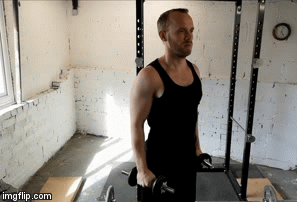
Dumbbell Wide Grip Upright Row
- This primarily hits the anterior and lateral deltoids, with the wider grip allowing for more emphasis on the lateral head.
- Start with the dumbbells in front of the body, with the back of your hands facing away from you.
- Shoulders should be retracted (pulled back)
- Raise the dumbbells, keeping the elbows above the wrists at all times.
- Make sure the dumbbell is relatively close to the body.
- Stop when the elbows are level with shoulders or slightly below. Any higher could cause shoulder impingement.
- Lower slowly under control.
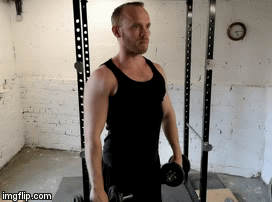
Seated Arnold Press
- A variation of the dumbbell press which targets all three heads of the deltoid, though mainly the anterior and lateral heads.
- Use a bench with a near vertical incline.
- Begin with rounded shoulders, palms facing toward you and dumbbells slightly above shoulder height.
- As you raise them, externally rotate the shoulders so the palms are facing forward. Bring the dumbbells together above the head, using the cue to press them “behind your ears” as you bring the head forward.
- Re-trace the movement pattern back to the start position, keeping everything controlled.
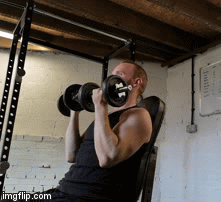
Thanks for reading!
